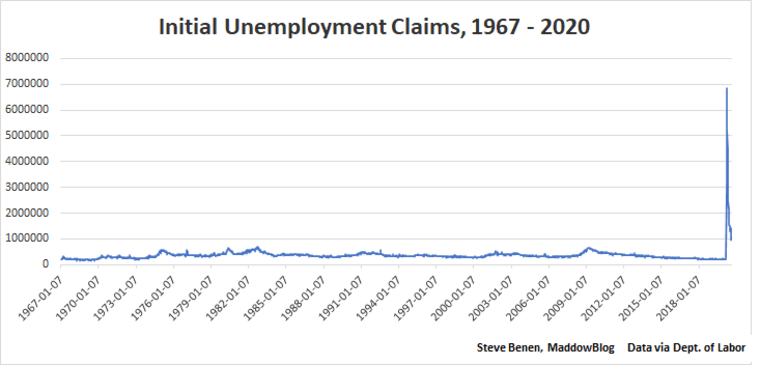
For 20 consecutive weeks, at least 1 million Americans filed for unemployment benefits -- a total vastly higher than anything the nation saw at the height of the Great Recession. Last week, however, brought some heartening news, as initial jobless claims fell below the seven-digit threshold for the first time since March.
As we discussed last week, the good news didn't last long, and the dip below 1 million lasted just one week. The latest report from the Labor Department shows a modest improvement over the previous report, but the totals remain stubbornly highly.
In the week ending August 22, the advance figure for seasonally adjusted initial claims was 1,006,000, a decrease of 98,000 from the previous week's revised level. The previous week's level was revised down by 2,000 from 1,106,000 to 1,104,000. The 4-week moving average was 1,068,000, a decrease of 107,250 from the previous week's revised average.
The cumulative effects continue to matter: these 1 million Americans who've just filed for jobless benefits are in addition to the totals from the last several weeks. In other words, we've seen than 58 million initial unemployment claims filed since mid-March -- a total unlike anything the country has seen in modern times.
A reader recently asked me a good question about this statistic: if 58 million Americans have sought jobless benefits, why do most reports indicate that roughly 31 million Americans are out of work? The answer is, many of those who were forced from the workforce after the crisis began in earnest were laid off temporarily, and have since either returned to their new jobs or found new ones. That said, the fact that there are roughly 31 million Americans still looking for a job is a brutal total by any fair standard.
This, coupled with today's discouraging report, reinforce the fact that this is a terrible time to have halted the $600-per-week federal supplement, which expired last month. Nevertheless, the lifeline is gone, unable to overcome Republican opposition. (The $300-per-week stopgap measure recently touted by the Trump White House isn't yet broadly reaching American households.)
I put together the above chart, and at the request of some readers, it shows weekly unemployment filings since 1967, when the federal government started keeping track. (I've also made the line a little skinnier to help show the recent drop from last month's spike.) The image may make it appear as if the last half-century has been relatively stable, but that's really not the case: there were significant peaks and valleys throughout this period.
But those fluctuations now seem minor by comparison.

